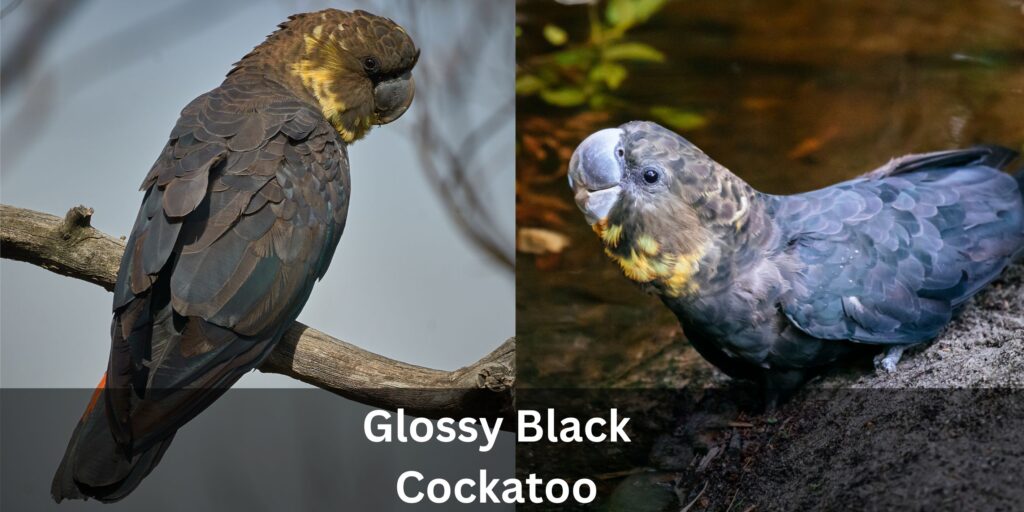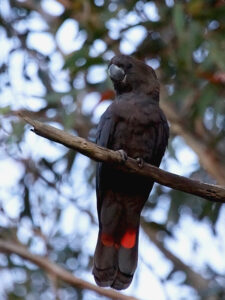Introduction for the Glossy Black Cockatoo
- The glossy black cockatoo is the smallest species of black cockatoo native to Australia.
- Once common across the southeast, habitat loss has made this unique parrot a vulnerable species.

Physical Characteristics
- 33-36 cm in length with all-black plumage and short squared tails.
- Males can have dull brown breast and head feathers.
- No crest on the head
- Namesake glossy sheen to feathers, especially on the crown. Bold red tail bands underneath are visible during flight.
- Females have greyish cheeks compared to the full black faces of males.
- Females sport yellow spots in random places on the neck and head
- Juveniles initially have brownish plumage before moulting black, Juveniles can also have yellow blotches.
- Bulbous bill shape
Key Scientific Naming Details for the Glossy Black Cockatoo:
- Scientific Name: Calyptorhynchus lathami
- Etymology: Genus Calyptorhynchus means “hidden bill” referring to the bare facial patch. The species name Lathami honors British ornithologist John Latham.
- A recognized subspecies is the Kangaroo Island glossy black cockatoo (C. l. halmaturinus).
Behavioural Traits of the Glossy Black Cockatoo
- Social, forming small flocks or pairs. The call is a far-carrying wailing cry.
- Primarily herbivorous, feeding on seeds of she-oak and casuarina pine cones. Also, eat insects like grubs.
- Nest in tree hollows, females lay single egg clutches and share brooding duties.
- Intelligent and can form strong bonds with caretakers when hand-raised.
Interesting Fact on Glossy Black Cockatoo
The glossy black cockatoo mates for life. Pairs engage in bonding rituals like preening each other’s feathers.
Diet and Nutrition for the Glossy Black Cockatoo
- A specialized diet is heavy on casuarina and she-oak pine cone seeds. Also, eat apple gum seeds.
- Captives require quality seed mix, greens, and sprouted legumes. Cuttlebone provides calcium.
- Fresh water is supplied daily. Nutritional supplements can help balance captive diets.
Caring for Glossy Black Cockatoo Birds
- Minimum cage size of 1.5 cubic meters for this active species.
- Natural branch perches, rope perches, climbing ladders and plenty of toys.

Health and Common Ailments of Glossy Black Cockatoo
- Prone to psittacine beak and feather disease. Test new birds.
- Obesity is a concern with poor diet. Monitor weight and trim nails/wings regularly.
- Alert and active birds are healthy. Watch for lethargy and poor appetite.
Training and Interaction with Glossy Black Cockatoo
Training tips:
- Target training assists with husbandry and handling. Use treats to motivate.
- Discourage loud vocalizations. Redirect chewing to appropriate toys.
Bonding:
- Plenty of supervised out-of-cage time lets bonds develop through interaction.
- Offer affectionate preening and head scratches. Shower perch is great enrichment.
Interesting Fact:
Glossy black cockatoos are incredibly long-lived, with records of individuals reaching 60+ years old in captivity.
Breeding Glossy Black Cockatoo Birds
- Breeding is challenging. Few captive programs exist.
- Legal restrictions prevent private breeding in Australia. Permits are required elsewhere.
- Both parents are devoted to rearing, and feeding the chick for 9+ months until fledges.
Purchase, Buy, Pet a Glossy Black Cockatoo
- Highly restricted as pets even where legal due to threatened status.
- Minimum 2 cubic meter cage. Destructive chewing must be managed.
- Noisy, requiring ample attention. Experienced owners are best.
Legal Considerations for Glossy Black Cockatoo
- Protected native species in Australia, and parts of Indonesia.
- Permits are needed for ownership elsewhere. Check municipal exotic pet laws.
- Never remove from the wild. Support responsible captive-bred programs.
Notable Varieties or Mutations in Glossy Black Cockatoo Breed
- No color variants. Subtle regional size differences of 1-3 cm across populations.
- Yellow-tailed Black Cockatoo
- Red-tailed Black Cockatoo
Famous Birds of the Glossy Black Cockatoo Breed
- Filmed for the documentary “An Earthling’s Guide to the Birds”. Featured bird “Neva”.
Habitat and Range of the Glossy Black Cockatoo
- Inhabits open eucalypt woodlands in southeastern Australia. Also New Guinea.
- Scattered flocks across inland regions of Queensland, New South Wales, and Victoria.
Conservation Status of the Glossy Black Cockatoo
- Listed as vulnerable. Habitat loss severely diminished populations.
- Protected in reserves. Nest box programs aid breeding efforts. Still under threat.
Resources and Further Reading
- Birdlife Australia’s Black Cockatoo Recovery program.
- Glossy Black Conservancy organization.
Conclusion
The specialized glossy black cockatoo depends on a fragile habitat niche vulnerable to destruction. Support habitat conservation initiatives protecting existing woodlands. Reduce land clearing near key breeding areas. With help, this unique cockatoo’s future can be secured.